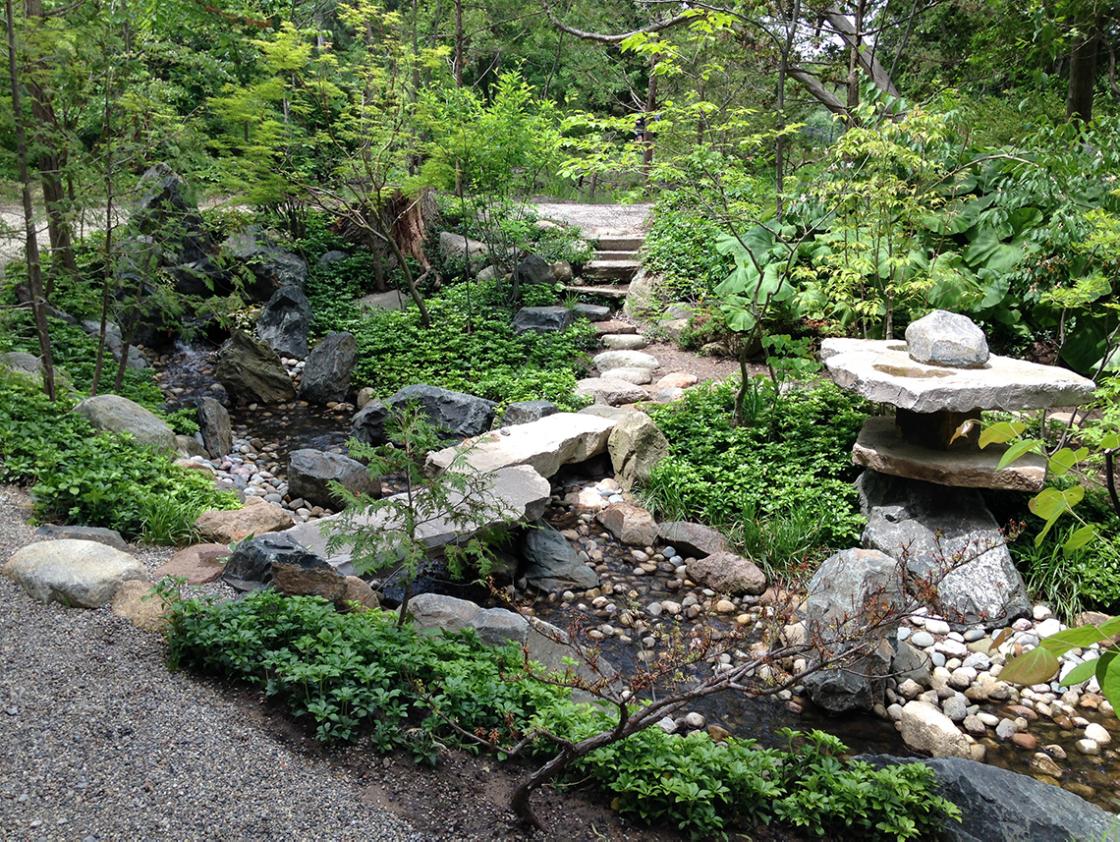Cranbrook Japanese Garden
Open all year, daily from dawn to dusk
The Cranbrook Japanese Garden is among the oldest Japanese-style gardens in North America. Created in 1915 as a part of the country estate of Cranbrook’s founders George and Ellen Booth, this one-acre, pond-style strolling garden, is located at the eastern edge of Kingswood Lake, midway between Cranbrook House and Cranbrook Kingswood Upper School. The garden, which is centered on the Lily Pond and its two small islands, features an iconic vermillion Japanese-style bridge, the original 1915 Japanese Kasuga Lantern, and the recently rehabilitated Lily Pond Cascade with its new Mountain Lantern.


You are invited to explore this idealized representation of nature, follow its winding paths, cross its natural stone bridges, seek shade under the many mature cedars, admire the changing vistas from various viewpoints, and embrace the garden as your own. It is a place of beauty and solace in all four seasons.
Guided Tours
Center staff guided tours of the Japanese Garden have been added to the public tour calendar on one Sunday a month at 1:30pm, May through October. Reserve a space on a tour to hear the story of the Cranbrook Japanese Garden and the Center's ongoing efforts to rehabiliate this historic landscape.

Hours and Information
Visitors are welcome to explore the Cranbrook Japanese Garden, which is adjacent to Cranbrook House and its gardents, throughout the year. Cranbrook Gardens—featuring a formal Sunken Garden, terraced flower gardens, fountains and statuary, wildflower and bog gardens, lakes and streams—is open daily during the following times:
Spring (Preseason): March 14 - May 30 | 7:00am - 7:00pm
Summer (Tour Season): June 1 - September 30 | 7:00am - 7:00pm
Fall/Winter (Off-season): October 1 - March 13 | Dawn to dusk

Location and Parking
Parking is available in the Cranbrook House & Gardens parking lot, which is located across from Christ Church Cranbrook.
Cranbrook House & Gardens
380 Lone Pine Road
Bloomfield Hills, Michigan 48304
Restrooms
An accessible restroom is located at the entrance to the Cranbrook House & Gardens parking lot. Restrooms are closed during the off season (November through April).

Paths to the Japanese Garden
Many trails will lead you through Cranbrook Gardens to the Japanese Garden. Click below for a map of the gardens and paths. We recommend you begin your journey on "The Mountain" and explore the grounds of Cranbrook House before making your way down to the trail that surrounds Kingswood Lake and takes you to the Japanese Garden.

Accessibility
The Cranbrook Japanese Garden is a historic landscape preserved and maintained as closely as possible to its original design. As such, there are certain natural and artificial surface conditions, such as grass, wood chips, stones, stairs, steep slopes and uneven terrain which can make walking and use of a wheelchair difficult. Assistance for persons using wheelchairs or walkers is recommended. Cranbrook Educational Community is a private, non-profit educational community that welcomes individuals to its public areas and is committed to providing reasonable accommodations for those who may require them.

Although the Cranbrook Japanese Garden is a place of beauty and inspiration, attracting thousands of visitors each year, it needs regular maintenance and further rehabilitation. Learn more about ways to support the garden, including giving and volunteer opportunties.
Cranbrook Center for Collections and Research works with a small group of committed volunteers to help rehabilitate one of the oldest Japanese gardens in North America. Working directly under the supervision of Emily Fronckowiak, Michigan’s only APA Certified Aesthetic Pruner, Volunteer Gardeners spend one day each month during the growing season (April through October) in the garden.
Cranbrook Center for Collections and Research provides a context for the Japanese Garden through educational programs that explore the culture and arts of Japan. These have included chanoyu tea ceremonies, lectures by contemporary Japanese garden designers, a lecture about the relationship between Frank Lloyd Wright and Japan, and wagashi, shodo, and ikebana demonstrations.
Explore the history of the Cranbrook Japanese Garden, from its creation dating back to 1915 to the present day research taking place. Included is the Cranbrook Japanese Garden Historic Landscape Study that was completed in 2018 following the Secretary of the Interior’s Guidelines for the Treatment of Cultural Landscapes.
CONTACT INFORMATION
The maintenance and rehabilitation of the Cranbrook Japanese Garden is the responsibility of Cranbrook Center for Collections and Research and the Cranbrook Japanese Garden Advisory Group. Please contact us at 248.645.3307 or center@cranbrook.edu.
CRANBROOK JAPANESE GARDEN SPONSORS


PHOTO CREDITS
Cranbrook Japanese Bridge, July 16, 2019; Photography by Eric Franchy.
Rehabilitated Lily Pond Cascade, June 14, 2019; Photography by Gregory Wittkopp.
Japanese Bon Festival, August 2024; Photography by Shintaro Nabeshima.
Cherry Blossoms in the Cranbrook Japanese Garden, Spring 2023; Photography by Gregory Wittkopp
Kasuga Lantern in the Cranbrook Japanese Garden; Photography by Thomas Booth.
Cranbrook House, July 18, 2013; Photography by Eric Franchy.
Path to the Cranbrook Japanese Garden along the Willow Pond and over the Corduroy Bridge, October 9, 2018; Photography by Eric Franchy.
Japanese Garden Bridge, 2025; Photography by Amy Klein.
Japanese Bon Festival, August 2024; Photography by Shintaro Nabeshima.
Japanese Garden Volunteers, 2024; Photography by Amy Klein.
Chanoyu Tea Ceremony in Cranbrook's Frank Lloyd Wright-designed Smith House, August 2018; Photography by Kevin Adkisson.
Japanese Garden Bridge, 1995. Photography by Cynthia Reno Waldeck. Courtesy of Cranbrook Archives.
